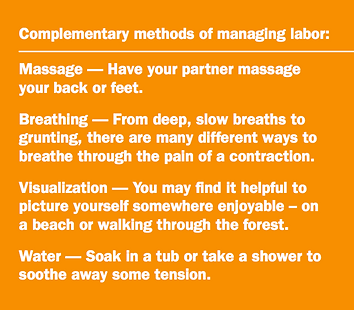


How Can You Ease Labor Pain?
Epidural This is the most common type of labor pain relief. If you choose to have an epidural, a member of the anesthesia care team will insert a needle and tiny tube, called a catheter, in the lower part of your back. An epidural numbs only the lower part of your body below your belly button and allows you to be awake and alert throughout labor, as well as feel pressure to push when it’s time to deliver your baby. It can take about 15 minutes for the pain medication to work, but you can continue to receive it as long as you need it, and increase or decrease the amount you receive as necessary.
Spinal block This can be used alone or combined with an epidural. You’ll feel no pain, only numbness from your abdomen to your legs. A spinal block can be used for vaginal childbirth as well as for a planned cesarean section, or C-section. The pain relief is immediate and lasts from one and a half to three hours, but it could wear off before your baby is delivered.
Analgesics Pain medications (opioid and non-opioid) are delivered through an intravenous (IV) line into a vein or injected into a muscle. Analgesics can temporarily relieve pain but don’t eliminate it.
General anesthesia This is the only type of pain medication used during labor that makes you lose consciousness. It works quickly and is typically used only if you need an emergency C-section or have another urgent medical problem (such as bleeding). You will not be awake for the birth of your baby.
Are Epidurals Safe? Many women who use medication to manage their pain during labor choose an epidural. While epidurals are very safe, you should be aware of some potential side effects including:
Decrease in blood pressure: The medication can lower your blood pressure, which can slow your baby’s heart rate. To decrease this risk, you will be given extra fluids through a tube in your arm (IV line) and may need to lie on your side to increase blood flow.
Sore back: Your lower back may be temporarily sore where the needle was inserted to deliver the medication. This soreness shouldn’t last more than a few days.
Headache: Rarely, the covering of the spinal cord may be pierced when the needle is placed, which can cause a headache that may last a few days if it is not treated. Women sometimes ask if an epidural can slow labor or lead to a C-section. There is no evidence that it does.
Childbirth and Pain Control

